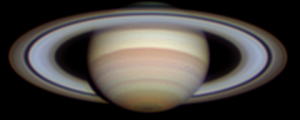2020 July 5
Observer’s Challenge – Saturn 2020

Saturn is an object many amateurs like to observe due to its magnificent ring system. The planet will be observable over the next few months with opposition occurring on 2020 July 20. Currently, the north face of the rings is presented to the Earth with an inclination of just over 21 degrees at opposition. Consequently even a very small telescope should allow their detection.

Despite this, Saturn is still worth observing and set out below are three observing challenges. These should be feasible whether you are observing visually or by imaging using small or large telescopes.
The first challenge is to observe the so called ‘Opposition effect’.
This phenomenon is when the rings show a noticeable surge in brightness for a day or two either side of opposition.
The second challenge is the detection of belts and zones on the planet’s disk.
Like Jupiter, Saturn shows a darker belts and lighter zones. However these are more difficult to detect on Saturn visually as they are often of lower contrast, are more subtle than those observed on Jupiter. Further Saturn has a smaller angular size than Jupiter. Telescopes in the range of 70 to 90mm aperture should reveal at least the major belt and zone on Saturn, if the seeing is good. Larger instruments may possibly reveal more. How many belts and zones can you observe?
Visual observers can use the report forms on the section web page. These forms provide outlines of the planet and rings at one degree intervals of ring inclination. The ring inclination on any date can be found in the BAA handbook (parameter DE) or via software such as WinJUPOS.
The third challenge is how many of Saturn’s satellites can be observed.
Saturn currently has the largest known family of satellites in the solar system and a few of these can be detected in amateur instruments.
The largest satellite is Titan. This is just fainter than 8th magnitude and so should be visible in a small telescope. Under good conditions, a 150mm aperture telescope should be able to detect three more (Rhea, Dione and Tethys) within the orbit of Titan. However a larger instrument may be required for their detection, if the planet is observed at a low altitude. These satellites will be easier to spot when they are at their maximum elongation from the planet. It may be possible with larger instruments or imaging techniques to detect the faint inner satellites Enceladus and Mimas. Two satellites orbit beyond Titan. Hyperion is faint but the third largest satellite, Iapetus, should be visible with a 150mm aperture telescope although again a larger instrument may be required if observed at a low altitude. Iapetus has an orbital period of just less than 80 days, and its maximum angular separation from Saturn exceeds 450 arcsecs. The key feature of this satellite is that there is a dark region on its leading hemisphere and so it shows slow variations in brightness as it orbits
The maximum brightness occurs when it is to the west of Saturn and it is at its faintest when to the east. One interesting project would be to image Saturn and Iapetus together when Iapetus is at its brightest and then at its faintest. Wide field imaging would be required given this satellite’s distance from Saturn at maximum elongation.
Predictions of the positions of the satellites can be derived from the BAA handbook or by software programmes such as Stellarium.
Please post your observations on the BAA members’ pages or e-mail them into the Saturn, Uranus and Neptune section via Saturn@britastro.org
| The British Astronomical Association supports amateur astronomers around the UK and the rest of the world. Find out more about the BAA or join us. |
